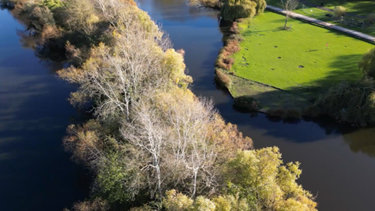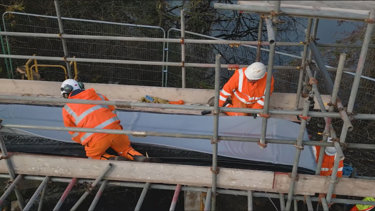Bespoke lining of 277-metre sewer pipe stops mass infiltration and prevents unnecessary lake water treatment
A major client tasked us with investigating a 277-metre sewer pipe located under the main lake in a large, popular public park. The pipe was full of silt, which we suspected was caused by mass water infiltration from the lake.

Framing the challenge
The 600mm gravity sewer pipe – which also runs through a small island – was found to be suffering from heavy infiltration due to large root ingress at the pipe joints.
A long-term solution was needed to prevent lake water from entering the sewer and subsequently increasing the flow to the local water recycling centre.
In the space of just one year, our scheme has already prevented 19.1 megalitres of water from going to treatment, saving energy equivalent to £30,000 and approximately 47,503 tonnes of carbon over 15 years.
Given the unique and challenging location of the sewer pipe, we developed an innovative solution specifically for this project which included robotic cutters and an additional waterproof membrane on the UV liner to prevent the infiltration from contaminating the resins within the liner.
Approach and implementation
We carried out an extensive programme of investigations and complex repair and sewer lining work.
One of the the initial tasks involved systematically cleaning and cutting roots from the 600mm sewer pipeline, using a portareel and chain flail.
We also isolated the pipe and utilised overpumping to maintain the water flow. This enabled us to clearly observe and locate the infiltration and calculate the amount of lake water that was infiltrating the sewer.

To minimise the infiltration prior to lining, we installed six localised structural repairs (patches) on the joints that had been most affected by the water ingress.
We specified and installed bespoke scaffolding over the upstream manhole for a launch platform that allow us to carry out the lining work. Once in place, we installed the bespoke UV-cured liner (which was specifically designed with an outer waterproof membrane due to the water ingress) to create an entirely new structural pipe within the host pipe.
“The repair works have helped improve many environmental factors. It is saving water being wasted and going to treatment plants. This improves water levels of the lake, which will help keep a steady oxygen level for the welfare of the fish. With a healthier lake, other invertebrates will be able inhabit it which will increase biodiversity and bring other species such as wading birds. Aquatic plants will also benefit.”
City Council Spokesperson
Innovation
We were able to measure and calculate the infiltration rate when the pipe was isolated at either end. Over a 36-hour period, the pipe was full of infiltrated water, which equated to 78m3 (or 52.21m3 of water in a 24-hour period).
From this, we could calculate the annual reduction in water being treated at the works and the associated electricity consumption savings as a result of lining the pipe and stopping the infiltration.
In the space of just one year, the scheme has already prevented 19.1 megalitres of water from unnecessarily going to treatment.
We worked efficiently and sustainably to preserve the lake’s future integrity as an established habitat for the local wildlife and as a local amenity.
One kilometre of aluminium track matting was installed through the sports fields to significantly minimise damage and offer safe access route to the site.
The use of trenchless technology reduced the time and heavy plant required on site compared to an open cut method, significantly minimising disruption to the local wildlife. This, in turn, reduced carbon emissions and the scheme’s overall environmental impact. It also prevented the risk of major pollution occurring in the well-stocked lake.
Impact and outcomes
The site’s public location meant the repair and lining work had to be carried out with pinpoint accuracy. Failure to carry out the work correctly could have led to the pipe collapsing and the need for a new sewer division (which would have cost millions of pounds), major disruption to the network, and associated overpumping costs.
Removing excess water from the sewage treatment works is anticipated to save energy equivalent to £30,000 over 15 years. The recycling centre uses 861 kWh per megalitre for water treatment. Therefore, the scheme has saved approximately 3,166 tonnes of carbon per year, which equates to 47,503 tonnes over 15 years.
The client now has a pipe that is secure from infiltration from the lake for many years to come. Our work has reduced electricity consumption at the works – and therefore carbon emissions – which is one of client’s environmental goals.
The site is of major local interest due to its proximity to the town centre, a local primary school and an Olympic-standard training venue.
Here to keep your pipework structurally sound and serviceable
Our experts are available now to help you understand and improve the condition of your assets.
Contact us

